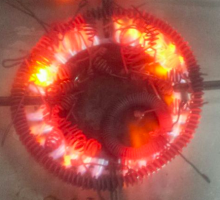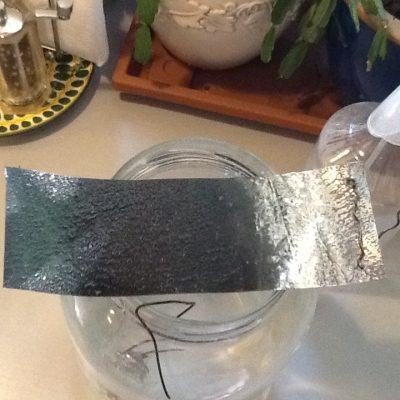Table of Contents
Nano revêtement, style téflon
 De la part d’Alekz, African confiné à Londres.
De la part d’Alekz, African confiné à Londres.
Nano revêtement style téflon de vos fils :
-
tremper d’abord vos bobines dans un mélange de GaNS
-
Mettez-les sur un poêle. Lorsqu’elles deviennent rouges et chaudes, vaporisez-les à distance avec de l’eau
-
Répétez cette opération toutes les 3 minutes jusqu’à ce que vous soyez satisfait de votre revêtement
- Drainez le courant avec votre voltmètre.
Vous vous rapprochez maintenant de votre appareil à énergie gratuite.
Nano-Coating with LP
by KF Romania
They have replaced distilled water in the caustic solution nano-coating process for MaGrav coils by LP of all the 4 basic GaNSes in equal measures; they have also assembled and tied the coils to the stacker structure.
As a result the coils have had a more homogeneous and blacker nano-coating. The black color appeared already after 30 min after they have been taken out of the caustic liquid. The nano-layers seem more coherent and don’t rub off easily.
Nano-coating by other elements
NaOH is normally used, KOH has recently been added – and other salt-like elements such as epsom salt (Mg) can be added. This gives other qualities to the coating, other field forces.
Mr.Keshe KSW175 @ 0:13:00
If potassium (K) is added, a different nano caoting is obtained. The addition of K can be done by a salt that is sodium free. There is also radioactive material called K40. This makes the nanoplating particles have more energy, they will therefore be spaced more apart and conduct the plasma more efficiently.
Aluminium nano-coating
- Heat 3 cups distilled water and 1 cup cold caustic solution (in a Crockpot) at 55-57ºC (134-136ºF)
- Soak the piece of aluminium very briefly and remove it
- Let it dry in the air
If you want to nano-coat aluminium cans:
- remove prints with nail polish remover
- pass the piece under the torch making very short passages (do not stop otherwise the metal melts)
Zinc Nanoplating
Zinc is not really tackled with caustic soda; HCL should be taken better. Paint the zinc plate with hydrochloric acid on both sides; place in an airtight container and leave to plating for 12 hours in a warm place (radiator).
HCL must be applied outside, as very corrosive vapours develop!
Nano-coating transfer
(par Mark House)

I used sea salt with a Cu-np electrode; the Zn plate was placed in the glass pot I use for GaNS-CO2 production; I decided to add some caustic soda crystals.
The result is that the nanoplating transferred from the Copper to the Zn plate.
The other two masson jars contained single copper coils with nano plated copper coils; in this example plating was also transferred.
So one can draw the conclusion that the ionization of carbon atoms can be transferred from the wires that were nano plated before onto another plate, coil or wire in a salt water environment with a little caustic.
By CaO
par Plasma-Laurentides
CaO is calcium oxide called quicklime. It is a white powder that reacts with water by a great release of heat. The reaction with water produces calcium hydroxide (slaked lime). :
Cao+H2O which gives Ca(OH)2; Hydrated lime should be basic enough for nano coating copper. It’s worth a try… so I did it and the result is a black coil.
Nanoplaquage plasmique
Par Donovan Guerra
Bonjour tout le monde! C’est toujours un plaisir de partager dans ce forum. Il y a des nouvelles exitantes; surtout les contributions de David Mulnix sur la page de Keshe Manufacturing Arizona. Ses reflexions étaient vachement aidant pour moi afin de faire du nanoplaquage par les forces du champ, ce qui est la 3e façon de nano-plaquer.
J’ai fait comme ça :
L’arrangement typique pour produire du GaNS CO2
Utilisez du sel de Seignette (sel de Rochelle, tartrate de potassium et de sodium, C4H4KNaO6), dans une solution de 10% au lieu du sel ordinaire (NaCl).
Placer n’importe quoi proche de la plaque de Zn se fait nanoplaquer dans quelques minutes; très épais après 24 heures. Cet arrangement n’utilise pas de courant.
Une variation : placer un fil de Cu proche de la plaque de Zn avec un peu d’eau de point 2) dans un sac en plastique (image en haut). Après une journée se montrait une bonne couche de nanoplaquage. La même chose se passe avec un collier en argent – après une journée il était noir. J’ai essayé de faire du GaNS avec les morceaux nanoplaqués avec succès.
Nanoplaquage – par le plasma
Par David Mulnix (USA-Plasma Times June 7, 2017)
Le plaquage est fait dans une installation conventionnelle pour la production de GaNS-CO2; l’objet à plaquer est installé en proximité de la plaque de Zn.
Le Cu va se nano-plaquer dans quelques minutes.
David a testé le Cu ainsi plaqué dans une installation de production de GaNS-CO2 avec succès.